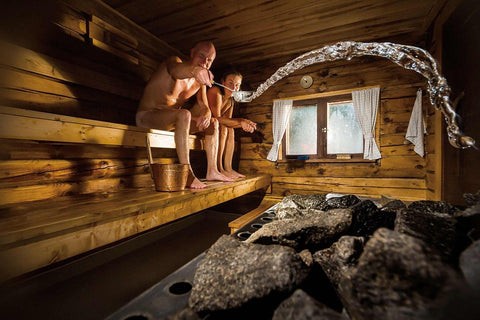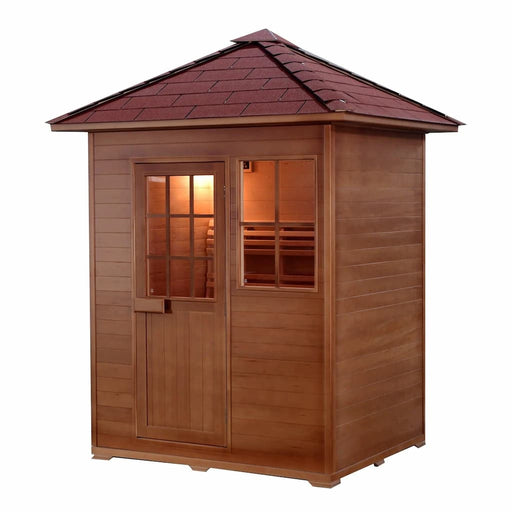Things about Traditional Sauna
5 Simple Techniques For Traditional Sauna
Table of ContentsGetting My Traditional Sauna To WorkSee This Report about Traditional SaunaTraditional Sauna Things To Know Before You BuyThe Best Strategy To Use For Traditional Sauna
Many of the weight lost in a sauna is water loss and is re-gained upon rehydrating. Without an uncertainty sauna can be a crucial component of a healthy weight loss program. To check out the differences between standard and IR saunas, I will certainly separate these right into verifiable, academic, and fabricated differences.Thus, the most popular factor in the saunawhich is at the ceiling directly over the sauna heateris usually between 185 and 190 F. Traditional Sauna. Claims that a conventional sauna goes beyond 200 F is just not real and not applicable for electrical saunas marketed in the US. The temperature level for a far-infrared sauna is normally established between 120 and 140 F; nevertheless, unlike the standard sauna, the objective in and IR area is not to achieve a heat
Due to this, the temperature level difference is almost irrelevant, considering that profuse sweating leads to both sauna types, however the method of warming the body is different. In an IR sauna the bather will certainly really feel hot and will certainly sweat profusely, however at a lot lower temperature levels. Therefore, if the objective is to spend longer periods of time in the sauna, the IR sauna is a great choice.

See This Report on Traditional Sauna
When the high temperature is achieved, the components cycle on and off to keep the heat. Most standard sauna users delight in putting water over the rocks to produce heavy steam to increase sauna humidity degrees. The benefits of pouring water over the rocks include: making the area much more comfortable, dampening the nasal passages, and allowing the use of aromatherapy by mixing vital oils with the water.
In a far-infrared sauna, the warmth waves penetrate the body to properly warm the body and increase the body core temperature. To achieve this increased temperature level, Far-infrared emitters develop infrared power which is close to the same wavelength as that which the body naturally emitsoften referred to as the "Vital Variety" of 7 to 14 microns), so the power is well gotten by the body.
When the power goes into the body, it creates the body temperature level to raise and inevitably causes perspiration. In an infrared sauna it's vital for the emitters/heaters to click to investigate continue to be on almost regularly. Considering that there is no mass of rocks to preserve warmth, the sauna will cool down if the emitters turned off.
As mentioned over, the sauna bather in an infrared area intends to position himself before running emitters to obtain optimal take advantage of the warmth. The home heating time for the 2 rooms can be extremely various, relying on how the rooms are utilized. For a standard sauna, a bather must permit 30-40 mins for the room additional reading to attain a wanted temperature and to properly pre-heat the rocks.
Not known Factual Statements About Traditional Sauna
A well built sauna will normally accomplish a temperature level of 150-160 F in concerning 30-40 minutes (Traditional Sauna). For hotter temperature levels, the room may need to warm for a longer duration. When the room attains set temperature, the heater will cycle on and off, generally running concerning 50% of the time. The shielded walls and the heated rocks will keep the area hot and at secure temperature levels.
To some, 15 minutes was "wasted" while the infrared energy heated the timber panels view publisher site instead than warming a body, while others locate a pre-heated area to be much more comfy and believe an elevated starting temperature is needed to begin sweating. The length of advised use for each and every area is roughly the same (10-15 mins per session); however, because of the lower air temperature levels and the capability to feel the impacts of infrared heat much faster than a standard sauna, it is not unusual for a person to invest a total amount of 20-30 mins in an infrared sauna.
Typical saunas tend to be bigger (thus use more electrical energy) than infrared saunas, although conventional saunas are certainly offered in one and 2 person dimensions too. For a two-person standard sauna, 5x6 or 5x7 dimension is most popular. The leading bench can easily seat 2 or three individuals and is likewise enough time to relax throughout the sauna session.


The typical price per kWH of power in the U.S. is about $0.11, so a 4.5 kW heating unit will cost around $.50 to compete one hour, if the heater runs constantly for one hour. Normally a sauna heating system will compete 75% of the first hour and 50% of subsequent hours on since the components cycle once the established temperature is accomplished.
Fascination About Traditional Sauna
A two person far-infrared area is typically physically smaller sized than a traditional sauna, often regarding 4' x 4' or smaller sized. The IR heater is generally 1.5-1.7 kW using a 120 volt 15 amp plug-in solution. Considering that the room can be utilized faster than a sauna area, we will certainly presume the space is made use of for to of an hour including warm up time.
There is a seldom talked about difference in the social experience in between the 2 rooms. While our culture has shed a few of the social advantage of the standard sauna experience, it can be extremely socially gratifying. From family time in the sauna, to heart-felt discussions with better halves, to sauna partiesthe traditional sauna experience can result in intimate interacting socially.
Most higher end infrared rooms consist of colored light therapy, noise systems and full-glass fronts.